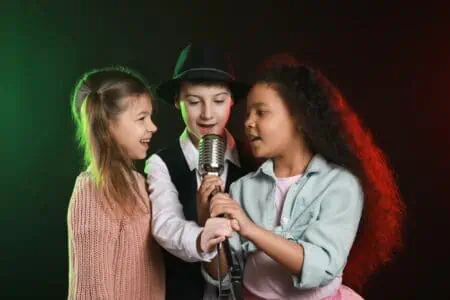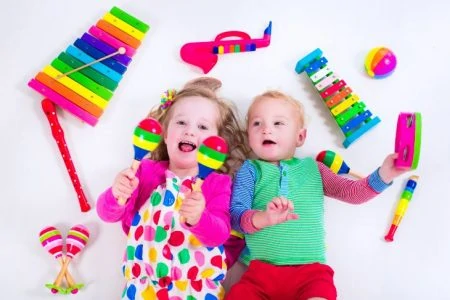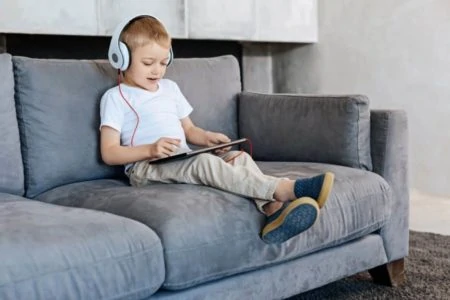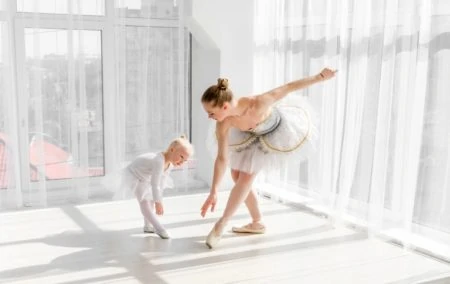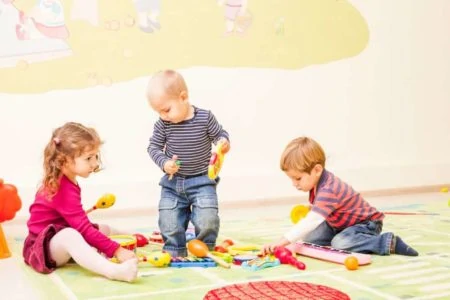Kids naturally love rhythm and movement. If “Musical Chairs” is getting a bit stale in your household or classroom, you might be looking for fresh inspiration.
We curated a list of 25 engaging music games for kids, ranging from equipment-free classics to fun gadgets you can grab online. Whether you want to boost their cognitive skills or just burn off some energy, these activities hit the right notes.
Get ready to boogie, move, and get groovy with these exciting musical games.
Teaching Musical Skills to Children
Teachers and parents play a huge role in fostering a love for music. You do not need to be a professional musician to teach the basics. Musical skills cover a wide range of abilities including listening, notation, singing, instrument manipulation, pitch recognition, and rhythm.
For beginners and young children, focus on these foundational skills:
- Listening: Active listening helps children distinguish between different sounds, pitches, and rhythms. It lays the groundwork for identifying instruments later.
- Singing: Vocalizing helps children internalize music. Encouraging your child to sing builds confidence and helps them understand melody structures.
- Dancing: Movement is one of the most effective ways to teach rhythm. Kids naturally want to move, so dancing to their favorite tracks keeps them engaged and active.
If you want to introduce these concepts in a fun way, the following 25 music games are perfect for home or school use.
25 Music Games for Kids
Life is simply better with a soundtrack. Even if your child doesn’t become a concert pianist, music appreciation enriches their life. It prepares them for future concerts, theater trips, and social events. Check out these harmonious games to spark that joy.
1. Musical Chairs
This is a party staple for a reason. Musical chairs is excellent for sharpening listening skills and reaction times. To play, line up chairs back-to-back. You need one fewer chair than the number of players.
Play music and have the kids walk around the chairs. When the music stops, everyone must scramble to sit down. The person left standing is out. Remove one chair and repeat the process until you crown a winner.
Mix It Up
Switch up the music genres. Use fast songs for quick walking and slow songs for dramatic, slow-motion walking.
2. Musical Statues
This game is similar to musical chairs but requires no equipment. It works wonders for self-regulation and listening. Play music and encourage the kids to dance. When you pause the track, everyone must freeze instantly. If a child moves or wobbles, they are out. Continue until one statue remains.
3. The Cup Song
Older kids and teens often love this challenge. Popularized by the movie Pitch Perfect, this rhythm game uses a sturdy plastic cup to create a percussion beat.
You will need to teach the specific “clap-tap-move” routine first. It requires patience, hand-eye coordination, and teamwork. Once the group masters the movements, try performing it along with the song “Cups” by Anna Kendrick. It is a fantastic brain workout that sounds great when done in unison.
4. Stinky Pig
Stinky Pig adds a hilarious twist to the classic “Hot Potato” concept. It is a handheld game featuring a soft vinyl pig that sings. It is ideal for toddlers and preschoolers who are learning to react to auditory cues.
Gather the kids in a circle. Poke the pig’s belly to start him singing, then pass him around. The player holding the pig when he stops singing and “toots” must take a token. The goal is to have the fewest tokens at the end. It causes plenty of giggles while teaching turn-taking.
5. Musical Masterpiece
This game combines art and audio. It works best with a group of three or more elementary students. Place a piece of paper and markers at each seat.
Play some music and have the kids start drawing. When the music stops, they must leave their paper and move to the next desk. When the music resumes, they continue drawing on their neighbor’s paper. By the end of the game, the group creates collaborative, abstract art inspired by the rhythm.
6. Super Simple, Kids Songs App
Parents of toddlers likely know the Super Simple Songs YouTube channel. They also offer an app filled with games and videos.
This is a digital option that helps keep music education going during travel or quiet time. It is packed with nursery rhymes and interactive elements suitable for kindergarteners. It keeps little ones entertained while reinforcing melody and lyrics.
7. Bop It!
Bop It! is a high-energy electronic game that tests reflexes and rhythm. It shouts commands like “Twist it,” “Pull it,” or “Bop it,” and players must respond instantly.
This is excellent for building auditory processing speed. You can play solo to beat a high score or pass it around in a group setting. Since it gets progressively faster, it is a hit with older kids and teens who enjoy competition.
8. One Little Elephant
This interactive school game teaches balance and counting through song. Place a piece of string or tape on the floor. Have a child walk along the “tightrope” while the group sings:
One little elephant balancing,
Step by step on a piece of string,
Thought it was such tremendous fun,
That [Child’s Name] called for another elephant to come.
The first child picks a friend to join them on the string. Repeat the verse, increasing the number of elephants each time. On the final round, the string “breaks” and everyone playfully falls down.
9. Boom, Snap, Clap
This is a rhythmic hand game that requires zero equipment. It functions like a complex secret handshake. Partners face each other and perform a sequence of chest thumps, finger snaps, and high-fives.
It challenges memory and coordination. Watch the video above to learn the pattern, then slow it down for beginners. It is a great way to bond and focus.
10. Dance Mat
For kids who learn best through full-body movement, a dance mat is a solid investment. It turns your living room into an arcade.
Connect the mat to a screen, and it lights up to show kids where to step. They must match their feet to the beat. This improves gross motor skills, timing, and cardiovascular health.
11. Yes/No Game
Choir directors often use this for vocal warmups. The teacher sings a short melody using only the words “Yes” or “No.”
The students must repeat the melody back, but they have to switch the words. If the teacher sings “Yes, yes, no,” the students sing “No, no, yes.” It forces the brain to separate the pitch from the lyrics, which is a difficult but rewarding skill for young musicians.
12. Simply Piano: Learn Piano Fast
If private lessons are out of budget, the Simply Piano app is a highly-rated alternative. You just need a piano or keyboard and a smartphone or tablet.
The device listens to the notes your child plays and gives instant feedback. It gamifies the learning process, making practice feel like play. It is suitable for ages four and up.
13. DIY Band
You do not need expensive gear to make noise. Encourage creativity by building a “junkyard band” with household items.
Pots and wooden spoons make great drums. Rice inside a sealed container becomes a shaker. Rubber bands over a tissue box simulate a guitar. This activity teaches children that music is accessible anywhere and encourages them to explore different timbres.
14. Guess the Instrument
This is a listening exercise for the classroom or car rides. Play a song with distinct instrumentation and ask the children to identify what they hear.
Start with obvious ones like drums or trumpet. As they get better, introduce more subtle sounds like a bass guitar or violin. It trains the ear to isolate specific sounds within a complex mix.
15. Whoosh Bang Pow
This drama game is perfect for energizing a group. Stand in a circle and pass a “Whoosh” (sound and hand motion) to the person on your right.
A player can stop the Whoosh by saying “Bang” and putting up a shield with their hands, which reverses the direction. A “Pow” allows a player to point across the circle and send the energy to someone non-adjacent. It keeps everyone on their toes and builds group rhythm.
16. Name That Tune
This classic trivia game works for two players or a whole class. Play the first few seconds of a popular song. The players race to guess the title and artist.
You can organize this by themes, such as Disney songs, pop hits, or TV show themes. It tests musical memory and pop culture knowledge.
17. Draw the Music
This is a relaxing activity that links auditory processing with visual expression. Give the kids art supplies and play a piece of evocative music (classical works well).
Ask them to draw how the music makes them feel. Fast music might inspire jagged lines and bright colors, while slow music might result in soft waves and cool tones. There are no wrong answers here.
18. Upbounders Musical Crossroads
This is a matching game designed for toddlers and preschoolers. The deck features diverse characters and musical instruments.
Kids flip cards to find matches, which helps with visual memory and focus. The musical theme provides a great opportunity to talk about different instruments, like accordions or saxophones, as you play.
19. Musical Hide and Seek
Add a sonic twist to traditional Hide and Seek. One person hides a Bluetooth speaker or a device like a Yoto Player while the other players wait in another room.
Play a song through the device. The seekers must use their listening skills to locate the hidden music. It helps children practice sound localization and navigation.
20. Finish the Song
This is a fun challenge for kids who love to sing. The leader sings a line from a well-known song and stops abruptly. The kids must fill in the next line with the correct lyrics and melody.
This reinforces lyrical memory and pitch accuracy. Use nursery rhymes for younger kids and radio hits for older students.
21. Rock Band
Rock Band revolutionized rhythm gaming. Players use instrument-shaped controllers to simulate playing guitar, bass, and drums.
While it is an older console game, it is still one of the best ways to teach polyrhythms and band cohesion. The drummer must keep the beat while the singer stays on pitch. It offers a genuine feeling of musical performance.
22. Karaoke Party
You cannot go wrong with karaoke. It is the ultimate confidence builder. Pull up instrumental lyric videos on YouTube and let the kids take the stage.
Using a wireless microphone adds to the fun. It teaches children to project their voices, read lyrics in real-time, and overcome stage fright.
23. Musical Note Coloring Book
For a quieter activity, try a theory-based coloring book. This book by Chef Home Cookd uses clear graphics to introduce musical notation.
As children color, they become familiar with symbols like treble clefs and quarter notes. It is a low-stress introduction to reading music.
24. Musical Trivia
Test your students’ knowledge with a quiz. Create categories like “Identify the Instrument,” “Finish the Lyric,” or “Music History.”
This encourages children to learn facts about composers, genres, and the science of sound. You can play in teams to foster cooperation.
25. Musical Storytime
Enhance your reading sessions with a soundtrack. As you read a book, ask the children to suggest songs or make sound effects that match the story.
If a character is running, they might drum their knees. If a character is sleeping, they might hum a lullaby. This connects narrative structure with musical expression.
Benefits of Music for Kids
Research consistently shows that music supports education and development. Beyond just being fun, music engages the brain in unique ways. It links to language acquisition, motor skills, and emotional intelligence.
Here are the key benefits of incorporating music into playtime:
- Cognitive Boost: Music improves memory and spatial intelligence. Studies suggest it can even help with math skills and SAT scores.
- Emotional Regulation: Listening to or playing music allows children to express emotions they might not have words for yet. It is a powerful mood regulator.
- Social Skills: Games like “The Cup Song” or forming a band require teamwork, listening to others, and synchronization.
- Coordination: Dancing and playing instruments enhance fine and gross motor skills.
- Neural Activity: Children with musical training often show larger growth in neural activity compared to those without.
- Cultural Awareness: Music exposes kids to stories and sounds from different cultures and time periods.
- Discipline: Learning an instrument requires patience and practice, teaching kids the value of perseverance.
